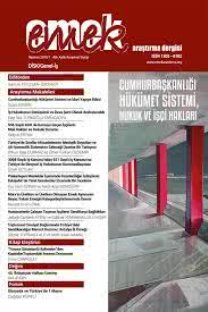Türkiye’de Gelir Grupları ve Hanehalkı Yapısı Çerçevesinde Maddi Yoksunluk
Toplum içinde olağan kabul edilen mal ve hizmetlere erişememe ve/veya fa- aliyetleri yerine getirememe olarak tanımlanabilecek maddi yoksunluk, yok- sulluğun izlenmesi için önemli bir gösterge oluşturmaktadır. Avrupa Birliği dü- zeyinde de “yoksulluk ve sosyal dışlanma riski” altında bulunan nüfusun tespit edilmesinde göreli yoksulluk ve istihdam yoğunluğu ile birlikte bir kıstas olarak kullanılmaktadır. Diğer taraftan, Türkiye’de maddi yoksunluk uzun zamandır he- saplanmasına rağmen ayrı bir gösterge olarak ele alınmaktadır. Avrupa Birliği ülkeleri ile karşılaştırıldığında Türkiye’de çok daha büyük bir nüfus grubu mad- di yoksunluk içinde olduğu halde bu konuda yapılmış çalışma sayısı sınırlıdır. Bu çalışmanın iki amacı bulunmaktadır. Bunlardan ilki Türkiye’de gelir düzeyi ve maddi yoksunluk arasındaki ilişkiyi ortaya koymaktır. İkinci ise farklı hanehal- kı yapılarına göre maddi yoksunluğun nasıl dağıldığını belirlemektir. Çalışmada TÜİK’in Gelir ve Yaşam Koşulları 2019 Araştırması mikro verileri kullanılmıştır. Elde edilen bulgulara göre, maddi yoksulluğun sadece düşük gelir gruplarının yaşadığı bir sorun olmadığı bunun ötesinde üst gelir gruplarını da etkilediği gö- rülmektedir. Buna ek olarak hanehalkı yapısına göre tek ebeveynli hanelerin di- ğerlerine göre çok daha fazla maddi yoksunluk içinde olduğu söylenebilir.
Material Deprivation in Turkey by Income Groups and Hou- sehold Structure
Material deprivation, which can be defined as the inability to access goods and services and/or to carry out activities that are commonplace in the society is an important indicator for monitoring of poverty. It is also used as criteria together with relative poverty and employment intensity in determining the population under the “risk of poverty and social exclusion” at the European Union level. On the other hand, although material deprivation has been calculated for a long time, it is considered as a separate indicator in Turkey. Compared to the Euro- pean Union countries, despite the portion of material deprivation group in pop- ulation in Turkey is larger, the number of studies on this subject is limited. This study has two aims. The first of these is to reveal the relationship between in- come level and material deprivation in Turkey. Secondly, it is to determine how material deprivation is distributed according to different household structures. In the study, TURKSAT Income and Living Conditions 2019 Survey micro data were used. According to the findings, material poverty is not only a problem of low income groups, but also affects high income groups. In addition, in terms of household structure, it can be said that single-parent households are more materially deprived than other groups.
___
- Aslan, G. (2020). İşgücü Piyasası Durumu, İstihdam ve Maddi Yoksunluğun Algılanan Sağlık Durumu Üzerine Etkileri. Çalışma İlişkileri Dergisi, 11 (1) , 53-68.
- Boarini, R. and d’Ercole, M.M. (2006). Measures of material deprivation in OECD countries. OECD Social Employ- ment and Migration Working Papers, No. 37, OECD Publishing (2006).
- Duiella, M. and Turrini, A. (2014). Poverty developments in the EU after the crisis: a look at main drivers. ECFIN-E- conomic Brief. European Union.
- Eurostat (2022). Glossary: Material Deprivation. https://ec.europa.eu/eurostat/statistics-explained/index. php?title=Glossary:Material_deprivation (2021 edited) (Erişim tarihi: 9.112021)
- Eurostat. https://ec.europa.eu/eurostat/statistics-explained/images/1/10/Severe_material_deprivation_ra- te%2C_2015-2019_%28%25%29_SILC20.png. (Erişim tarihi: 20.02.2022).
- FDHA (2022). Poverty and Material Deprivation, https://www.bfs.admin.ch/bfs/en/home/statistics/econo- mic-social-situation-population/economic-and-social-situation-of-the-population/poverty-and-materi- al-deprivation.html, (Erişim tarihi: 18.02.2022).
- Fusco, Guio and Marlier (2011). Income poverty and material deprivation in European countries. Working Paper No 2011-04 January.
- Gürsel, S., Uysal, G. ve Kökkızıl, M. (2014). Üç Çocuktan İkisi Şiddetli Maddi Yoksunluk Çekiyor. Araştırma Notu.
- Guio, A. and Maquet, I.E. (2006). “Material deprivation and poor housing” Draft paper for the conference“ Comparative EU Statistics on Income and Living conditions: issues and Challenges”. Helsinki. November. https://ec.europa.eu/eurostat/statistics-explained/index.php?title=Glossary:Material_deprivation (2021 edited) (Erişim tarihi: 9.112021)
- Hick, R. (2015), ‘Three perspectives on the mismatch between measures of material poverty’, British Journal of Sociology, 66, 1, pp. 163–172.
- Karcı ve Arlı (2018). Maddi Yoksunluğu Etkileyen Değişkenlerin Lojistik Regresyon Analizi ile Belirlenmesi. Süleyman Demirel Üniversitesi İktisadi ve İdari Bilimler Fakültesi Dergisi, 23 (3), 1039-1048
- OECD (2007). Glossary of Statistical Terms. “Material Deprivation”. https://stats.oecd.org/glossary/detail. asp?ID=7326 (Erişim tarihi: 10.02.2022).
- Özdamar, Ö. , Kılınç, Z. S. ve Giovanis, E. (2021). Türkiye’de İşsizliğin Ekstra Maliyeti ve İşsizlik Ödeneklerinin Maddi Yoksunluk Üzerine Etkisi. İzmir İktisat Dergisi, 36 (3), 535-554. DOI: 10.24988/ije.202136303.
- Turgut, M. (2021). Türkiye’nin Maddi Yoksunluk Oranındaki Değişimin İncelenmesi. Uluslararası Finansal Eko- nomi ve Bankacılık Uygulamaları Dergisi, 2 (1) , 63-108.
- TÜİK (2011). 2009 Yoksulluk Çalışması Sonuçları Haber Bülteni, http://www.tuik.gov.tr, (Erişim tarihi: 02.03.2011).
- TÜİK (2015). Gelir ve Yaşam Koşulları Araştırması, 2014 Haber Bülteni. http://www.tuik.gov.tr, (erişim tarihi: 20.02.2022)
- TÜİK (2020). Gelir ve Yaşam Koşulları Araştırması, 2019 Haber Bülteni. http://www.tuik.gov.tr, (erişim tarihi: 20.02.2022)
- TÜİK (2021). Gelir ve Yaşam Koşulları Araştırması, 2020 Haber Bülteni. http://www.tuik.gov.tr, (erişim tarihi: 20.02.2022).
- Ünver, Ş. ve Alkan, Ö. (2020). Modelling of the Factors Affecting the Material Deprivation Status of Individuals in Turkey. Business & Management Studies. An International Journal, 1370-1334 ,(2)8. https://doi. org/10.15295/bmij.v8i2.1457
- ISSN: 1305-6182
- Yayın Aralığı: Yılda 2 Sayı
- Başlangıç: 2005
- Yayıncı: Genel İş Sendikası
Sayıdaki Diğer Makaleler
Güvencesizlik Kıskacında Kafe-Bar Çalışanlarının Covid-19 Pandemi Deneyimleri: Kadıköy Örneği
Etik Bir Sorun Olarak ‘Bakım Açığını’ Kapatmak: Palyatif Bir Çözüm mü, Evrensel Bakım mı?
Türkiye’de İtfaiye Hizmetinin Anatomisi: Envanter Çalışmasından Notlar
Sonay BAYRAMOĞLU ÖZUĞURLU, Melih ÇELİK, Asmin KAVAS BİLGİÇ, Hilal KARA
Emek Gelirlerinde Asgari Geçim İndiriminin Etkinliği Üzerine Karşılaştırmalı Bir Analiz
Neoliberal Birey ve Özbakım Emeği
Türkiye’de Gelir Grupları ve Hanehalkı Yapısı Çerçevesinde Maddi Yoksunluk
İzmir’de Ev Hizmetlerinin “Yeni Portreleri”: Suriyeli Kadın Göçmenler
